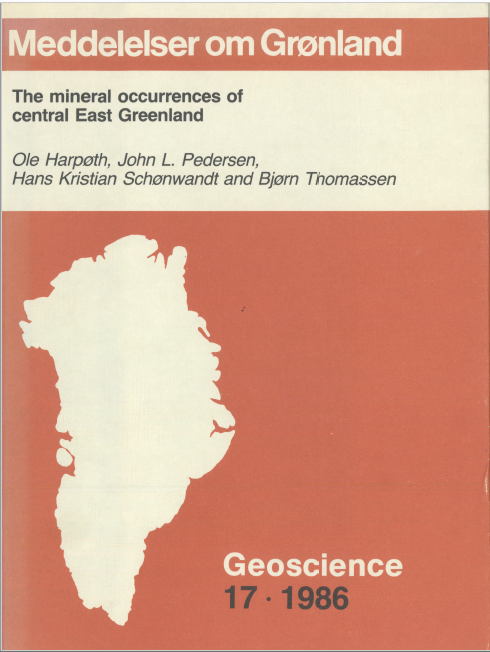The mineral occurrences of central East Greenland
DOI:
https://doi.org/10.7146/moggeosci.v17i.139824Abstract
The present monograph on the mineral occurrences of central East Greenland is the result of an agreement between Nordisk Mineselskab A/S and the Mineral Resources Administration of Greenland (Råstofforvaltningen for Grønland) on compilation of the mineral-exploration activity carried out in central East Greenland by Nordisk Mineselskab A/S during the period 1952- 1984. The main aim is to present geological descriptions of all known mineral occurrences and to compile most of the existing geochemical data in a manner applicable to future exploration in the area. More than 200 individual mineral occurrences are described and many in great detail. Geochemical data are presented for scheelite and for 16 elements relevant to the evaluation of the mineral potential of the area. The data are presented as single-element anomaly maps for both rock samples and panned heavy-mineral concentrates and include data from a file consisting of more than 10 000 rock samples and close to 4000 panned heavy-mineral samples.
Mineralization in central East Greenland occurs in rocks of Archaean to Oligocene age and has tentatively been grouped into several periods when mineralization took place.
Mineralization hosted in Archaean-Lower Proterozoic rocks includes magnetite and chromite accumulations and iron-sulphide segregations associated with ultramafic and mafic igneous assemblages, volcanogenic massive-sulphide occurrences, titaniferous magnetite and ilmenite occurrences associated with original plutonic anorthositic massifs, banded iron-formations, gold-bearing quartz veins, a complex copper-skarn occurrence, and uranium and gold-uranium occurrences of unknown origin.
Mineralization hosted in Middle and Upper Proterozoic rocks is restricted to lead-zinc and tungsten skarns and stratiform copper occurrences.
Mineralization hosted in Lower Palaeozoic rocks is in general believed to be associated with Caledonian orogenic activity. It comprises tungsten skarn occurrences mainly associated with granodiorite intrusions, base-metal and tungsten mineralization associated with late-kinematic probably calc-alkaline granite, tin-tungsten-arsenic quartz veins associated with late-kinematic probably mildly alkaline granites, gold-bearing quartz veins associated with late-kinematic granite, uraniferous veins in probably Devonian alkaline granite, tungsten-antimony-gold and silver-bearing base-metal veins in low-grade metamorphic sediments, uranium-fluorite veins in Devonian felsic volcanic rocks and strata-bound uranium occurrences hosted in Devonian elastic rocks.
Mineralization hosted in Upper Palaeozoic sediments (Carboniferous - Permian) includes base-metal quartz-baryte veins locally enriched in precious metals, goldbearing quartz veins. uraniferous veins, carbonate-hosted strata-bound baryte base-metal occurrences, carbonate-hosted strata-bound celestite occurrences, stratiform base-metal showings of Kupferschiefer type and strata-bound red-bed copper occurrences.
Mineralization hosted in Mesozoic sediments is represented by Triassic stratiform and strata-bound base-metal occurrences of red-bed type and Jurassic placers rich in zirconium and rare-earth elements.
Tertiary mineralization includes a major porphyry-molybdenum occurrence, granite roof-zone molybdenum mineralization, niobium mineralization associated with alkaline intrusive rocks, lead-zinc skarn occurrences, a minor magnetite-skarn showing, lead-zinc-bearing quartz veins and precious-metal, base-metal, molybdenum and fluorite mineralization associated with fumarolic volcanic activity.
The location of all mineral occurrences is shown on a separate map: Mineral Occurrences in Central East Greenland.

Downloads
Published
How to Cite
Issue
Section
License
Coypyright by the authors and the Commision for Scientific Research in Greenland / Danish Polar Center. No parts of the publications may be reproduced in any form without the written permission by the copyright owners.

